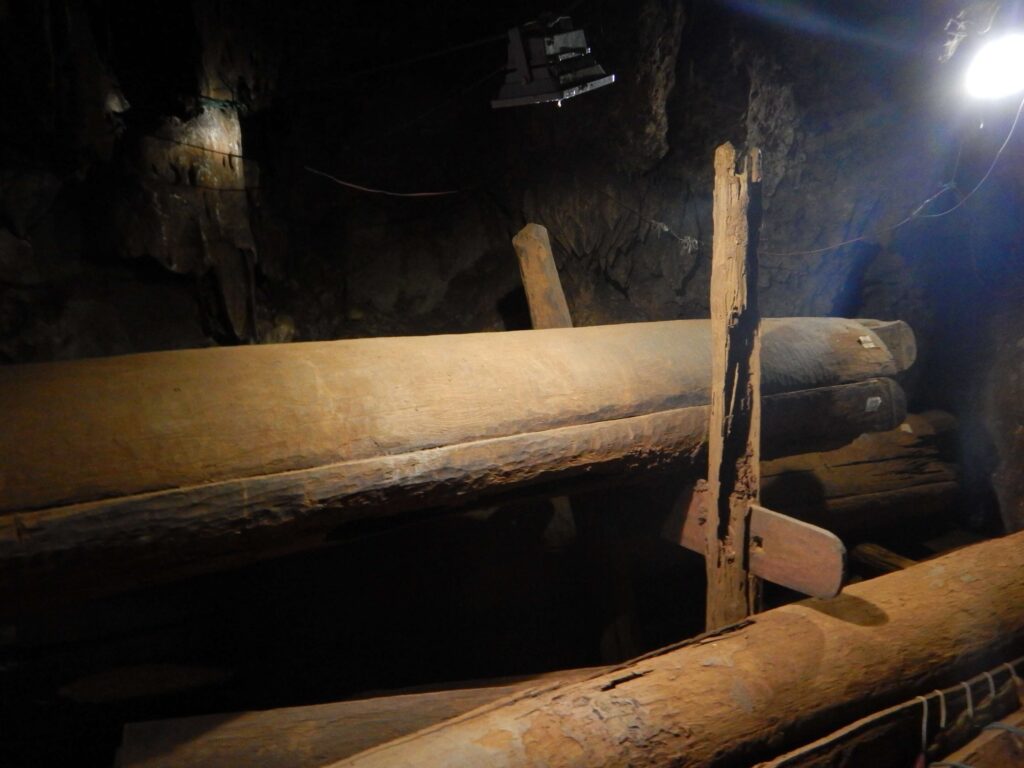Deep within the verdant embrace of Thailand’s northwestern highlands, limestone karst formations rise majestically. Lush deciduous and evergreen forests cloak the mountains, punctuated by a network of caves and rock shelters. Hidden within these caverns lie remarkable testaments to a bygone era – large wooden coffins, crafted from single teak trees and adorned with intricate carvings, stand sentinel on stilts.
These magnificent coffins, known as the Log Coffin Culture, have captivated archaeologists for over two decades. Dating back to the Iron Age, between 2,300 and 1,000 years ago, they have been found in over 40 caves scattered across the Mae Hong Son province. Each coffin, reaching up to several meters in length, speaks volumes about the skill and artistry of the communities who built them. The carvings adorning the handles, depicting geometric patterns, animals, or even human figures, offer tantalizing glimpses into their belief systems and artistic expression.
Professor Rasmi Shoocongdej, a leading archaeologist from Silpakorn University, has spearheaded the “Prehistoric Population and Cultural Dynamics in Highland Pang Mapha Project,” dedicated to unraveling the mysteries of these ancient communities. Their research delves into the intricate relationship between these people and their environment, alongside a crucial focus on their social structure and connections with earlier and later inhabitants of the region.

But a recent study has taken this exploration a giant leap forward. An interdisciplinary team of researchers from Germany and Thailand, led by Professor Shoocongdej, embarked on a groundbreaking project – analyzing the DNA extracted from 33 individuals buried in these ancient log coffins. This meticulous analysis, published in the prestigious journal Nature Communications, marks the first comprehensive genetic study of a prehistoric community in Southeast Asia.
“This project exemplifies the immense potential of ancient DNA in unlocking the secrets of past societies,” remarks Dr. Selina Carlhoff, the study’s lead author and researcher at the Max Planck Institute for Evolutionary Anthropology. “It sheds light on their daily lives, social structures, and the fascinating web of connections they shared with people from other regions.”
One of the biggest hurdles in studying ancient populations, particularly in Southeast Asia’s tropical climate, is the challenging task of DNA preservation. This has often limited past studies to single individuals or small groups, offering only a fragmented picture. However, the current research successfully navigated this challenge, revealing a captivating story.
The analysis unveiled a complex genetic landscape within these Iron Age communities. Interestingly, two distinct ancestral lineages were identified – one linked to the Yangtze River Valley and the other to the Yellow River Valley in China. While previous studies in neighboring countries hinted at the presence of Yellow River-related ancestry, it was notably absent in Bronze and Iron Age individuals from northeastern Thailand.
This genetic diversity reflects a cultural tapestry as well. The differences observed in burial practices and dietary patterns across regions point towards distinct spheres of influence and migration routes during the Neolithic period. The communities associated with the Log Coffin Culture likely had close ties with people from both the Yangtze and Yellow River valleys, highlighting the dynamic web of interaction within Southeast Asia during this era.
“Our findings add a crucial piece to the puzzle of Southeast Asia’s post-Neolithic genetic landscape,” says Dr. Wibhu Kutanan, a scientist from Naresuan University, Thailand, who played a key role in initiating the study. “While this research focused on samples from caves, future studies targeting open-air archaeological sites hold immense promise for further enriching our understanding of the region’s genetic history.”
The study also delved deeper, employing a novel technique to analyze “identical-by-descent” (IBD) blocks in the DNA. These blocks represent segments inherited from a common ancestor, allowing researchers to trace complex biological relationships within and across burial sites. This groundbreaking approach, never before applied in Southeast Asian archaeology, revealed fascinating insights.
The analysis identified close genetic relatives, such as parents and children or grandparents and grandchildren, buried together within the same cave systems. These clusters suggest a potential preference for burial sites based on kinship. However, the overall genetic makeup of the Log Coffin communities indicates a larger and interconnected population, with low levels of inbreeding and high diversity in mitochondrial DNA compared to the broader genome.
“This suggests a high degree of interaction and exchange between communities residing in different river valleys,” explains Professor Shoocongdej. “The use of wooden coffins in other Southeast Asian cultures opens exciting avenues for future collaborative research. By comparing relatedness patterns and genetic connections across regions, we can potentially unlock the secrets of cultural dynamics and population interactions throughout Southeast Asia and beyond.”
Source: Max Planck Society
